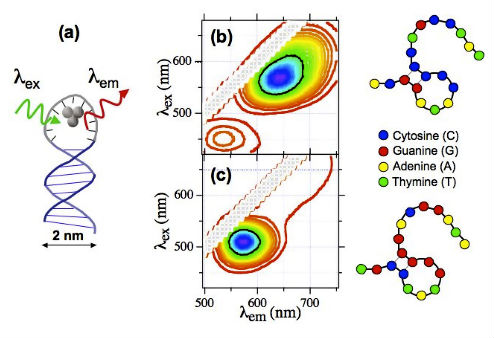Understanding how DNA sequence selects Ag-DNA color using computational techniques
 The connection between DNA sequence and Ag-DNA color remains poorly understood. It is well-established that the sequence of bases composing
the DNA templating strand selects the fluorescence color of the silver cluster, but no one knows exactly how this process occurs. A better understanding of the color selection process would not only increase
our understanding of how Ag-DNA are formed but could also lead to predictive design methods for new template DNA strands to stabilize clusters with desired characteristics.
The connection between DNA sequence and Ag-DNA color remains poorly understood. It is well-established that the sequence of bases composing
the DNA templating strand selects the fluorescence color of the silver cluster, but no one knows exactly how this process occurs. A better understanding of the color selection process would not only increase
our understanding of how Ag-DNA are formed but could also lead to predictive design methods for new template DNA strands to stabilize clusters with desired characteristics.
Our previous research showed that homopolymers of the four bases composing DNA (and RNA) display different aptitudes for hosting fluorescent silver clusters (DOI: 10.1039/c2cc17675k). However, generalizing these results to DNA oligomers of mixed base sequence is challenged by the huge space of possible sequences. To overcome these challenges, we are currently studying large data sets collected using robotic cluster synthesis and rapid array scanning to "crack the color code" that connects sequence to color. Our computationally minded studies are in collaboration with Prof. Ambuj Singh and Prof. Petko Bogdanov. We have recently shown that machine learning algorithms can be combined with motif mining to predict DNA templates for fluorescent silver clusters. DOI: 10.1002/adma.201401402
